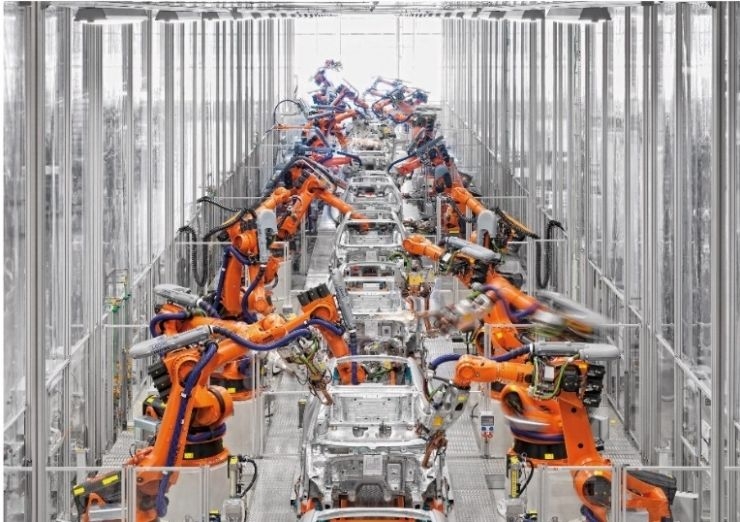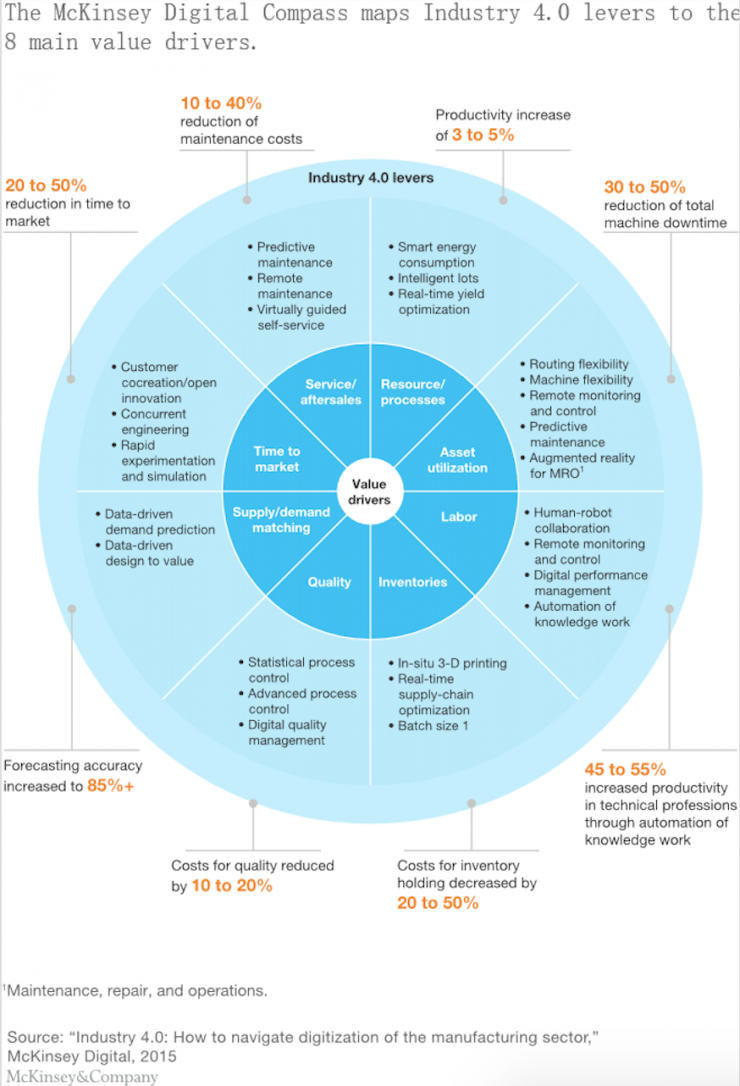
New wisdom: According to the author Paul-Louis Caylar, Kedar Naik, and Olivier Noterdaeme, source mckinsey, compiled by Xinzhi Sole, and refused to reprint without permission!
In the past few years, we have witnessed the benefits of digitalization to the industry, especially in data processing and manufacturing. However, as we all know, there is still a large amount of potential that has not yet been triggered. Taking the e-commerce platform as an example, it greatly optimizes the experience of traditional consumers. In addition, automation, big data analysis, and the advancement of the Internet have also brought great opportunities to the industrial value chain.
Another industrial revolutionThe sign of the digital revolution has arrived - In April 2015, Amazon.com was established as a new B2B e-commerce platform. Its first-quarter sales reached 1 billion, and then it grew at a rate of 20% per month. Buyers of Amazon B2B tend to use data when purchasing, and 94% of them will conduct some kind of online research before buying.
Other rules for changing the game include reducing the cost of new technologies (such as additive manufacturing and advanced robotics). Specifically, the cost of 3D printing was reduced by 60% between 1990 and 2014, while the cost of industrial robots was reduced by 5% per year between 2000 and 2012.

So, in the perfection of specific functions, what does digitalization bring us? Let's take a look at the effects of the digitalization that experts have summarized on various aspects.
In the oil and gas industry, regular maintenance replaces unplanned downtime and high maintenance costs; several factories that implement networking can use remote sensors to predict and report on the status and performance of the equipment. As a result, many potential problems are Can be detected and repaired as soon as possible.
The use of remote temperature monitoring capabilities has led to a significant increase in the productivity of the paper industry. The monitor in the furnace monitors the cement and also acts as an indicator of the calcination process. A variety of tools have been developed to achieve polymerization, they can analyze the temperature and automatically optimize the shape and density of the flame, allowing heat to circulate in the furnace. This process can save up to 6% of fuel and 16% of cement.
In the manufacturing industry, repeated, laborious and complicated tasks are completed by robots according to the operator's instructions. This not only affects the accurate information tracking of the items, but also directly affects the rationality of inventory repetitiveness; real-time analysis and advanced The control mechanism can directly identify errors and quality problems in the production process and reduce rework and scrap.
At the same time, we must not forget consumers because digitalization can reshape the way companies interact with consumers and provide services to consumers.
Consumers were once limited by the minimum order volume and the cost of a particular market, but today these restrictions have been broken by e-commerce platforms and online stores, and companies can reach out to those consumers whom they have never been able to reach before. Service fees will be reduced by 50% to 70%. Online malls like Amazon and Alibaba connect millions of sellers and buyers in the virtual world, and large distributors like Guillaume have established their own status – in 2015, they accounted for US B2B digital commerce sales. One trillion in China.
Suppliers who have relied on subjective analysis and lessons learned can now be priced with quick data-guidance tools. For example, a leading technology gas company with a series of highly fragmented products uses high-end data analysis and models to develop more strategic and logical pricing strategies. This new value-based pricing method will increase sales by 5%.
Sales executives can make more informed resource allocation choices based on timely sales data feedback, individual performance data and automated advice, while sales associates do not need to rely on their intuitive judgment of customer needs, but only need to use Targeted insights of the product and customer success stories attract new customers and increase cross-selling. As a result, income can increase by 5% to 15%, while consumer satisfaction can increase by 20% to 30%.
Digital Destructive PowerHowever, digitization is not the best way to optimize your company's current operations. It gives outside attackers and internal incumbents the ability to break the value chain, enter new areas, and create new business models. Companies that have already built will face threats from new competitors, such as Amazon Mall, which offers millions of products including automotive parts, industrial elevators, activity ladders, laboratory products, protection devices, and electronic devices.
To get rid of potential threats, industrial companies can digitally transform and expand their business models as attackers begin to attack and want to reshape their industries. Some industry players have joined the digital platform and B2B market to integrate end-user demand and sales. For example, BASF was the first chemical company to sell things on Alibaba. The entrepreneurial 3D printing company Sculpteo aims to sell services rather than products. Some companies also treat their manufacturing power as a service and provide it to third parties.
Are companies ready?
The industrial digital index of the McKinsey Global Institute shows that in the digitization process, the industry lags behind other industries. Specifically, the manufacturing industry and the oil and gas industry have achieved certain results in the digitalization process, while the basic supplies manufacturing industry, chemical industry and pharmaceutical industry are still in the early stage of development.
In addition, the McKinsey Industry 4.0 survey involved more than 300 manufacturing experts from Germany, Japan, and the United States. In January 2016, they stated that only 16% of manufacturers had implemented the Industry 4.0 strategy, and 24% had explicitly stated that they would implement it.
Six winning tipsTo sum up, companies that want to be at the forefront of digitalization need to open the following six top tips:
First, distinguish the order of implementation and expand the scale. Structured assessment methods are used to determine the preferences and willingness of customers to pay, and interviews are conducted through the use of product prototype design programs and potential customers and external experts. In addition, by assessing the degree of innovation or destruction to measure the potential impact and ease of implementation, define scalability, learn the feasibility and solutions of Pioneer Pioneer, determine its own existing capabilities.
Second, take the test and study method. The change in technology guidance is so fast that the relevance and reliability of forecasting and planning are reduced. Agility is still the key to testing and learning. When people invest in digital solutions, it is very important to accept the VC's mode of thinking.
Third, we must put the infrastructure in place. To maintain the efficiency and stability of current operations in order to provide processing power and speed for new data-led activities. A sensible company must quickly transition to a two-speed IT company. A rising star does not mean that it has absolute superiority, especially for those who deal with the data of different functional departments, systems and management.
Fourth, consider data as a competitive advantage. Data makes the algorithm more flexible and provides many factors that market, consumers, and companies can learn from. This ensures that data management has a clear architecture and management. You know, technology giants like Google have been unable to withstand minor attacks, so please confirm that you regard cybersecurity as the top priority of management.
Fifth, to coordinate organizational division across functional districts to manage organizational changes. Digitization requires that each department is closely integrated and work together for a company.
Sixth, when considering digital advantages, identify the potential impact of technology and applications. At the same time, don’t forget the barriers to people’s acceptance: Develop a plan that helps employees use new technologies and related new methods efficiently. It is important to remember that no organization can successfully complete the digital transformation without careful consideration or change of management methods.
The potential for digitization in the industrial sector is not limited to specific operations, but also the interaction between various industries, and the levers that allow the company's bottom line to constantly change – from e-commerce to automotive, and advanced analytical methods. Industrial companies must use digital opportunities to avoid the loss of value. The commitment of senior management on digitalization is crucial to success because it is an important force that can determine priorities and lead early successes to change.
Via mckinsey
Xinzhi made Lei Feng network (search "Lei Feng network" public number attention) (search "Lei Feng network (search "Lei Feng network" public number attention) "public number attention" (search "Lei Feng network" public number attention) under the focus of the robot The number of the public, we are concerned about the status and future of robots, and related industries combined with robots. Interested friends can add micro signal AIRobotics, or directly scan the QR code below to follow!
